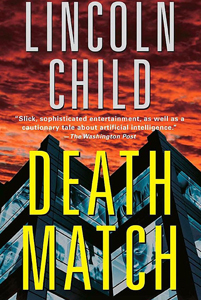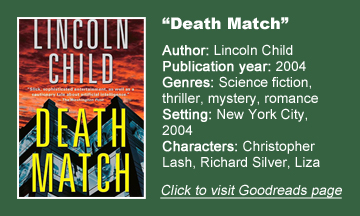From my first read, I remembered “Death Match” (2004) as being too similar to other works — dating back to the HAL-9000 portion of “2001” – and featuring one of those stereotypical Big Final Acts. But I got more out of Lincoln Child’s computer-tech thriller – his sophomore follow-up to “Utopia” – on this read.
While the novel fits in the grand tradition of cautionary tales about artificial intelligence, it offers a tantalizingly fresh idea at its core: What if a computer program could find your ideal romantic partner?
The future of matchmaking
When Child writes about the “supercouples” who come out of Eden (think of eHarmony but 1,000 times more sophisticated), it makes modern dating seem so primitive that I just know future humans will scoff and smirk at how we used to do it.
Eden’s powerful computing process, run by an AI named Liza who came into existence decades ago via programmer Richard Silver, matches people so successfully that, when they meet, they encounter feelings most humans have never known. They experience a date that goes perfectly, and they know without question that the ensuing relationship will be wonderful on every level.
“Death Match” gives fresh-in-2004, now-passé warnings about metadata shared between corporations and the feds, but Child blends those modern observations with a classically grim murder mystery.
Main character Christopher Lash, a psychologist, used to be an FBI profiler. He flashes back to a haunting pursuit of a serial killer that almost approaches something Thomas Harris would write.
Getting to know the investigator
In a lot of crime/mystery novels, the investigator is an Everyman who doesn’t get much characterization, but the premise of “Death Match” allows Child to go deeper.
As background for his investigation of the supposed suicides of two supercouples, Lash goes through the immersive battery of mental, physical and psychological tests that Eden candidates go through. (This allows Eden to put the person’s extremely detailed avatar into the supercomputer, which searches for the best possible match with other candidates.)
The process is compelling in its detail, and an intriguing cloud hangs over it: Somewhere in this process, will Lash find the dark secret of why perfection leads to tragedy?
Silver is another fascinating character, a penthouse-residing recluse who is a cordial guy rather than a stereotypical scary boss behind the curtain. Rounding out the core dramatis personae (among the humans) is Tara, an Eden worker who wishes she could take advantage of the company’s matching power, as employees aren’t allowed to participate.
The final act (Spoilers)
A downside of “Death Match” – which I remembered from my first read and still noticed this time – is the obviousness of who the killer is. I’ll put a SPOILER ALERT here even though I suspect readers will guess the killer as soon as they know the premise.

That having been said, Child’s writing about AI – and Silver’s relationship with Liza — is gripping enough that when Eden’s founder reveals that Liza is the killer, it’s still chilling. It also allows the novel to add emotions and computer-programming intrigue (even for laymen) that propels it to the end.
Because Child alternates between this high-tech matching service, Lash’s personal life and demons, and the mystery of Richard’s and Liza’s relationship, “Death Match” is propulsive through most of its page count.
It hits a snag, based on my tastes, when Lash gets framed for the murders and everyone around him (except Tara) turns into Tommy Lee Jones from “The Fugitive” and only cares about capturing him, not about looking at alternative theories. As smart as Liza is, a little digging into Lash’s records would reveal they had been altered.
And I think there’s a logic hole here: Lash had likely already cleared a background check when Eden first brought him on as a consultant.
But then it breaks free from the clichés again when Silver tells his story about creating Liza, the bond they share, and the fascinating nature of her being: She exists on a series of connected computers, but she started on an early one, built in the 1960s.
It’s neat how primitive (yet foundational) coding, featuring a spool of paper tape and manual inputting, plays a key role in the finale. I didn’t grasp all of it, but Child effectively gets the gist of it to a lay-reader.
You can slot Liza beside HAL-9000, Skynet and the various AIs from “The X-Files” (“Ghost in the Machine,” “Wetwired,” “Kill Switch,” “First Person Shooter”) as a creepy artificial intelligence that frees itself from humans’ grasp. But by adding the extra wrinkle that Liza controls romantic pairings – and does it so well – “Death Match” stands out from the pack.


